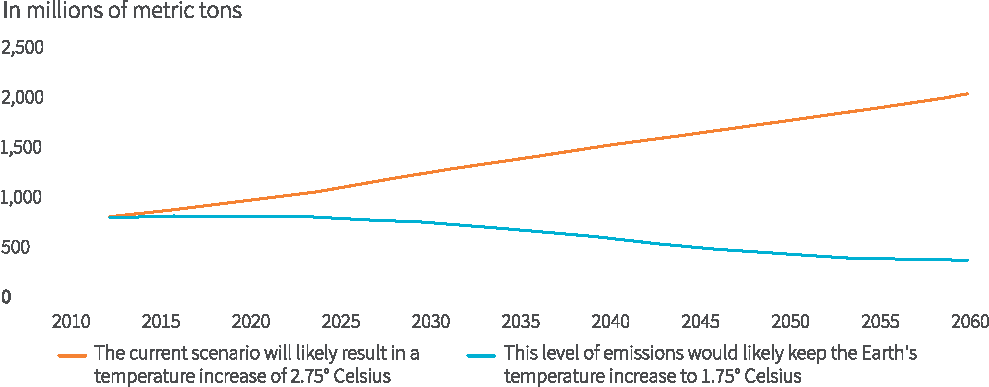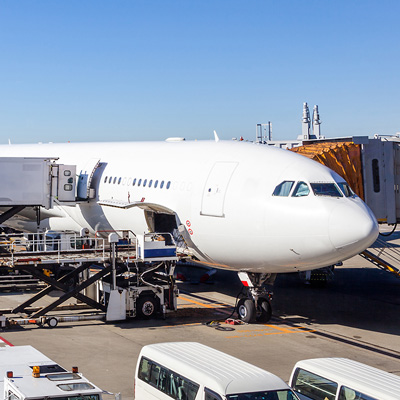By Jerome Bouchard and Eric Confais
A version of this article ran in Forbes on September 3, 2019.
Since the 1950s, aerospace has made incredible progress in increasing the power and efficiency of engines. Yet, recent studies suggest engine technology may be close to the themodynamic limits on the energy it can extract from carbon-based fuel at a reasonable investment. That means more travel and more aircraft will lead to increased fuel use and more greenhouse gas (GHG) emissions unless a suitable substitute for fossil fuel is found.
Today, the global aviation industry accounts for 2.4 percent of carbon dioxide emissions and about 12 percent of the greenhouse gases released by the transportation industry. But those percentages are expected to increase as demand for air travel, particularly in Asia, requires the addition of substantially more capacity. By 2029, revenue passenger kilometers could jump more than 60 percent to 12 trillion, and the size of the global fleet is expected to expand 42.5 percent to over 39,000 aircraft.
By 2050, the International Civil Aviation Organization (ICAO) predicts emissions from aviation could grow more than 300 percent. With that kind of increase, it’s likely the industry’s share of total greenhouse gas emissions will climb if no meaningful attempt is made to turn away from fossil fuels — especially given the success that other carbon-emitting sectors, such as electricity generation, have had switching to renewable energy sources.
Interim Solution
Because a complete solution to the emissions problem — a commercial jet powered entirely by something other than fossil fuels — is probably decades away, a few pioneering aerospace companies are borrowing an idea from the automotive industry and creating hybrids. Just as they did for cars, these propulsion systems — part internal combustion and part electric — could represent an interim strategy to cut emissions and fossil fuel consumption until fully sustainable electric or hydrogen-powered aircraft are developed. Given mounting evidence that the pace of climate change is accelerating, aviation can ill afford to wait two decades to address its emissions problem.
While hybrid automobiles don’t reduce emissions as much as fully electric vehicles, they do cut them almost in half compared to gasoline-powered cars. For aviation, going hybrid would still mean overcoming many engineering challenges and would require regulatory approval, but this alternative could be realized sooner than a fully electric airliner.
Research into the electrification of transportation is part of the global effort to avert large-scale drought and rising sea levels by reducing greenhouse gas emissions. While most nations and industries have pledged to do their part, carbon dioxide emissions continue to rise — up 2.7 percent last year, according to a Global Carbon Project report. Numbers from the International Air Transport Association show aviation emissions up 26 percent since 2013. With the pressure to stabilize the situation, aviation needs to come up with solutions in the next few years or face penalties under the United Nations-sponsored agreement titled the Carbon Offsetting and Reduction Scheme for International Aviation.
With electric cars and light vehicles expected to dominate auto sales by 2040 Emissions Analytics, a global testing and data specialist that measures real-world emissions and fuel efficiency, has argued that promoting hybrids in the short term my be more effective at cutting emissions over the long run. Why would not the same be true for aviation, given how elusive complete electrification of air transport is proving?
Working the problem
Representing a step toward lower emissions, hybrids are powered by both conventional kerosene-fed turbine engines and electric motors using “clean” power stored in batteries or produced by hydrogen fuel cells. This dual-technology propulsion system would be usable through all phases of flight, and besides lowering emissions, it would likely cut an aircraft’s consumption of jet fuel — the second biggest operating cost for airlines.
At least one small-scale attempt to assign some engine functions to electric motors has already been successful, but unfavorable economics stopped it from being adopted. In 2016, Safran Landing Systems and Honeywell abandoned an electric taxiing system that would have cut emissions and fuel use, especially for airlines that focus on frequent, short-haul flights. Low fuel prices made the system less attractive to carriers.
There have also been test flights of small hybrid aircraft. Among them, the University of Stuttgart's e-Genius plane conducted at least two successful flights over the Alps using a relatively complex propulsion system consisting of an electric motor, batteries, a generator, and an internal combustion engine. Similarly, Diamond Aircraft Industries and Siemens announced the first flight of a multi-engine hybrid electric aircraft late last year.
More ambitious hybrid experiments are underway as well. Most recently, SAS and Airbus announced a collaboration to create a hybrid electric aircraft for large-scale commercial use. At the Paris Air Show in late June, hybrid projects were unveiled by Airbus, Safran, Daher, and Eviation, an Israeli startup. Rolls-Royce also annouced its intention to acquire Siemens' eAircraft business at Le Bourget, another indication of growing commitments to an electric future.
Assuming Current Policy And No Major Technology Advances,
Aviation Carbon Dioxide Emissions Will Climb

Source: International Energy Agency, Energy Technology Perspectives 2017. www.iea.org/etp2017
Battery or fuel cell
Even with hybrids, there is a choice to be made between lithium-ion batteries, now commonly used in electric vehicles and smartphones, and hydrogen fuel cells. Each has advantages and drawbacks. For instance, lithium-ion batteries have a relatively low energy density per unit of mass compared with current kerosene-based jet fuel, meaning a larger and heavier battery is needed. With a hybrid, of course, that disadvantage is offset by the fact that the battery is backed up by a conventional internal combustion engine.
Battery recharging time also needs to improve for aircraft, particularly those that have just 30 minutes between flights. While a rapid-charging option has been in favor for electric cars, researchers are still trying to develop battery-swapping capability, despite early problems with the technology.
If battery-swapping succeeds for cars — an option with some economic and environmental concerns to overcome as well — it would allow a fully charged battery to be substituted for a dead battery in the time it takes to fill up with gasoline. It would also remove one impediment for battery use by aircraft.
Aviation’s share of global carbon dioxide emissions will climb if the industry fails to find workable substitutes for fossil fuel
Hydrogen power
Hydrogen fuel cells are another alternative being researched. The most abundant element on earth, hydrogen has a higher energy density per unit of mass than either kerosene-based jet fuel or batteries — some 33,300 watt-hours per kilogram versus 11,900 for conventional jet fuel and only a few hundred for batteries. Almost since the agency’s inception, the National Aeronautics and Space Administration (NASA) has used various forms of hydrogen — liquid, gas, and fuel cells — on manned and unmanned space flights, right through the space shuttle.
Three years ago, the HY4 — a four-seater using only an electric motor powered by a hydrogen fuel cell — successfully took off from the Stuttgart airport in Germany, staying airborne for 10 minutes. In Singapore, the world’s first regional hydrogen-electric passenger aircraft was unveiled in October 2018. Although considered aspirational by many in the industry, the company has reportedly already received inquiries from regional airlines.
Many aerospace executives privately discuss liquid hydrogen as the potential endgame for aircraft, emulating the propulsion design that the National Aeronautics and Space Administration (NASA) has used almost since the agency’s inception to power its rockets. Recently, NASA funded a program at the University of Illinois that aims to develop a fully electric aircraft platform that uses cryogenic liquid hydrogen as an energy storage method. But for several years, the agency also has been researching the development of hydrogen hybrid aircraft.
But hydrogen has drawbacks. Since hydrogen doesn’t exist on its own in nature, it needs to be separated from oxygen in water molecules or from carbon in natural gas. The technology to produce hydrogen and its storage can be pricey, and when separating it from natural gas, it ends up producing methane, another greenhouse gas.
Clearly, more must be done, and one of the biggest benefits of a hybrid strategy is that it may buy the aerospace industry the time it needs to create a flying machine that doesn’t use fossil fuels at all. Given the absolute necessity to cut emissions, an industry hybrid strategy that focuses on incremental solutions raises the prospect of real progress on reducing emissions in the near term, even as air travel expands.












